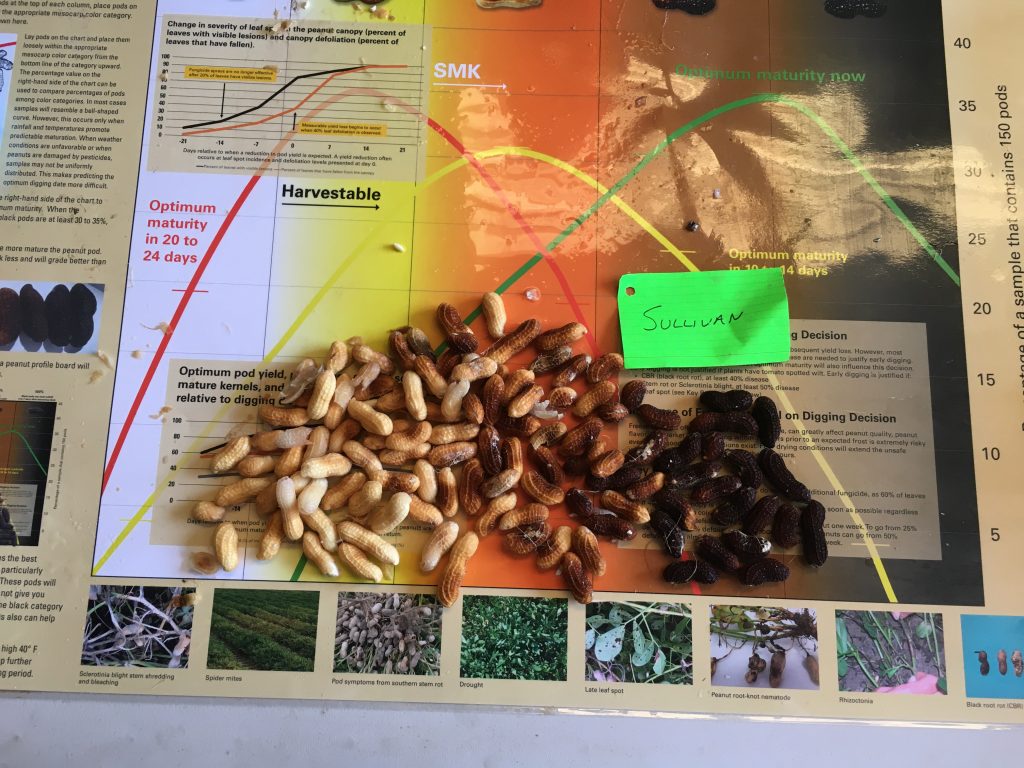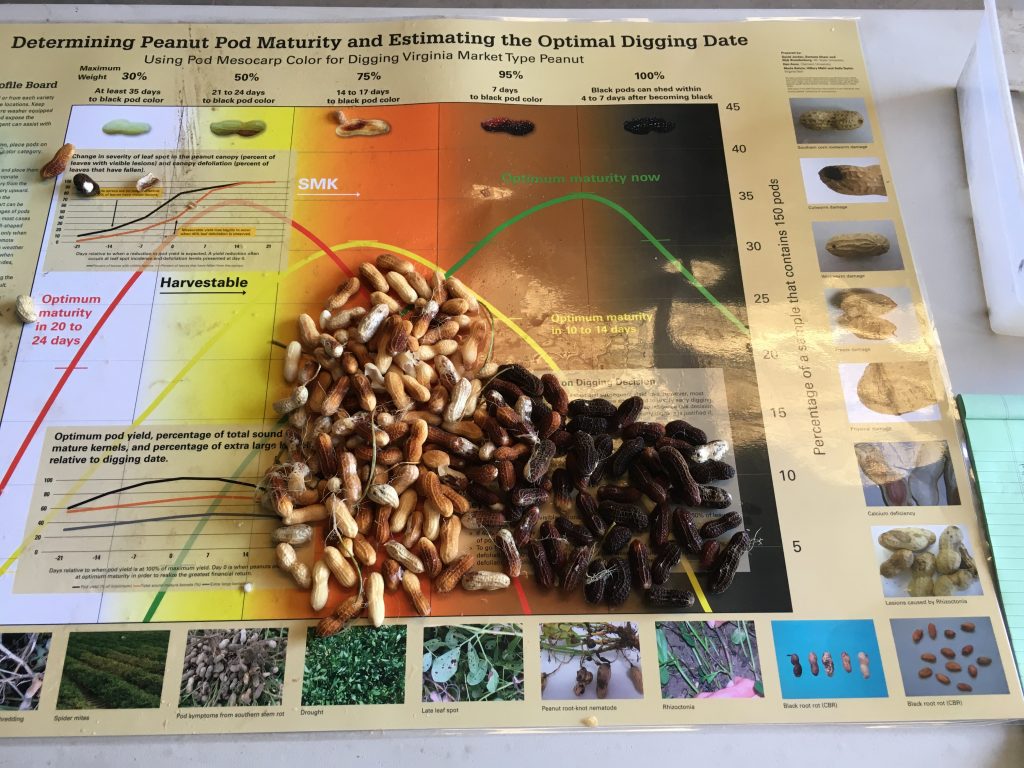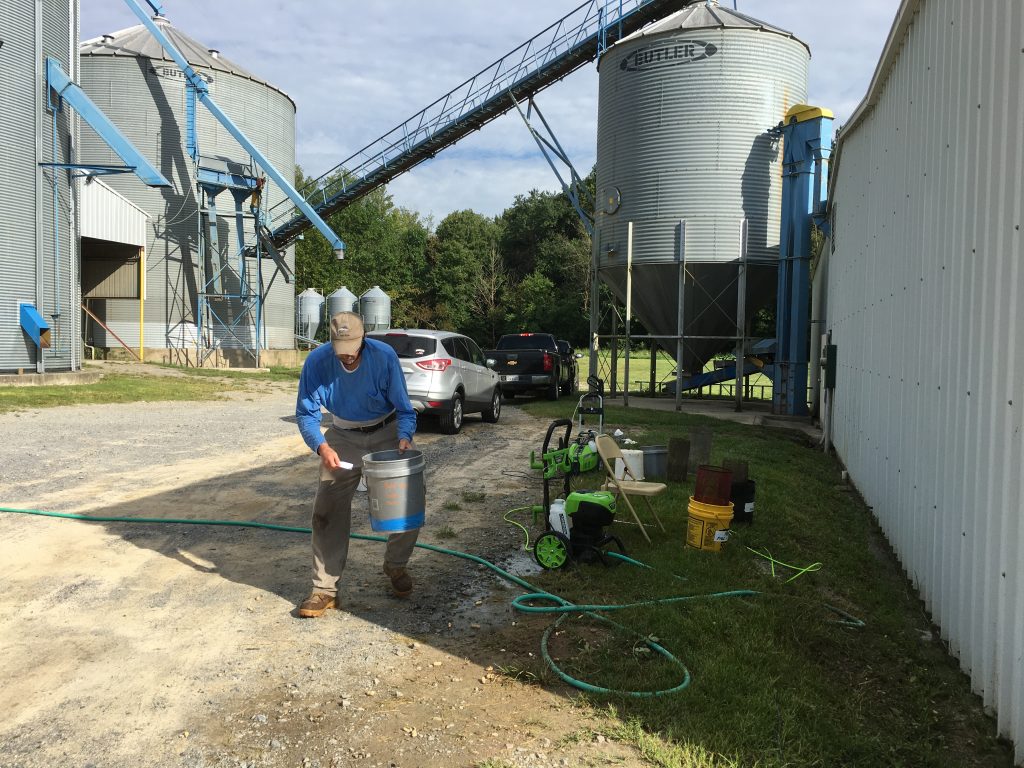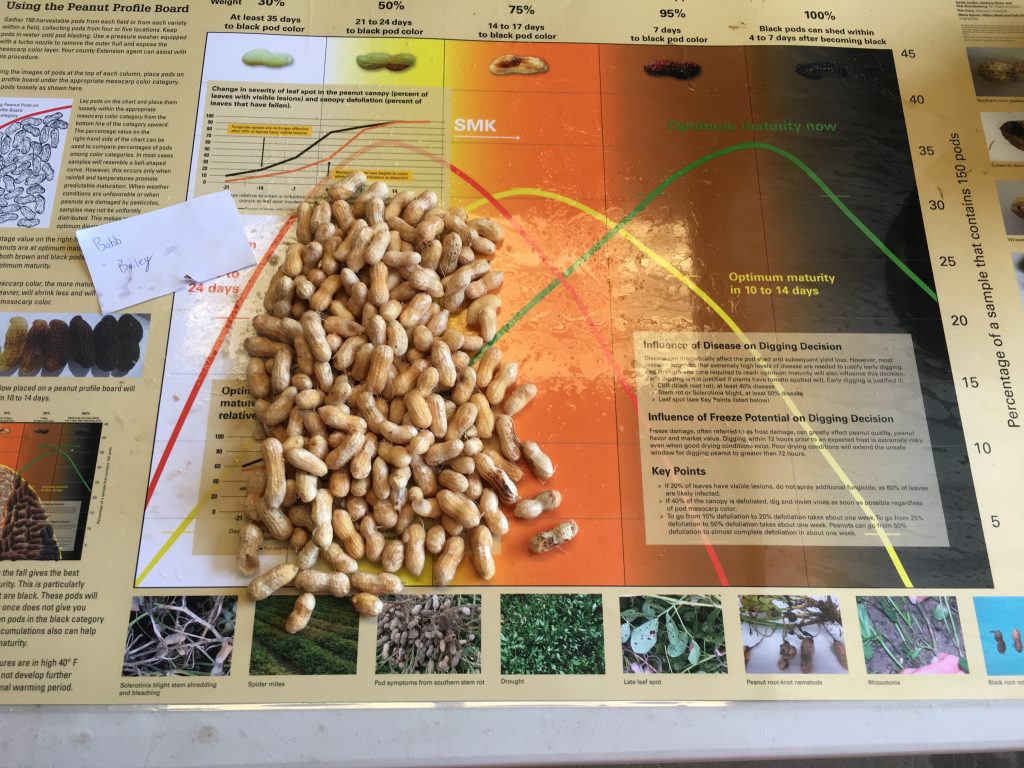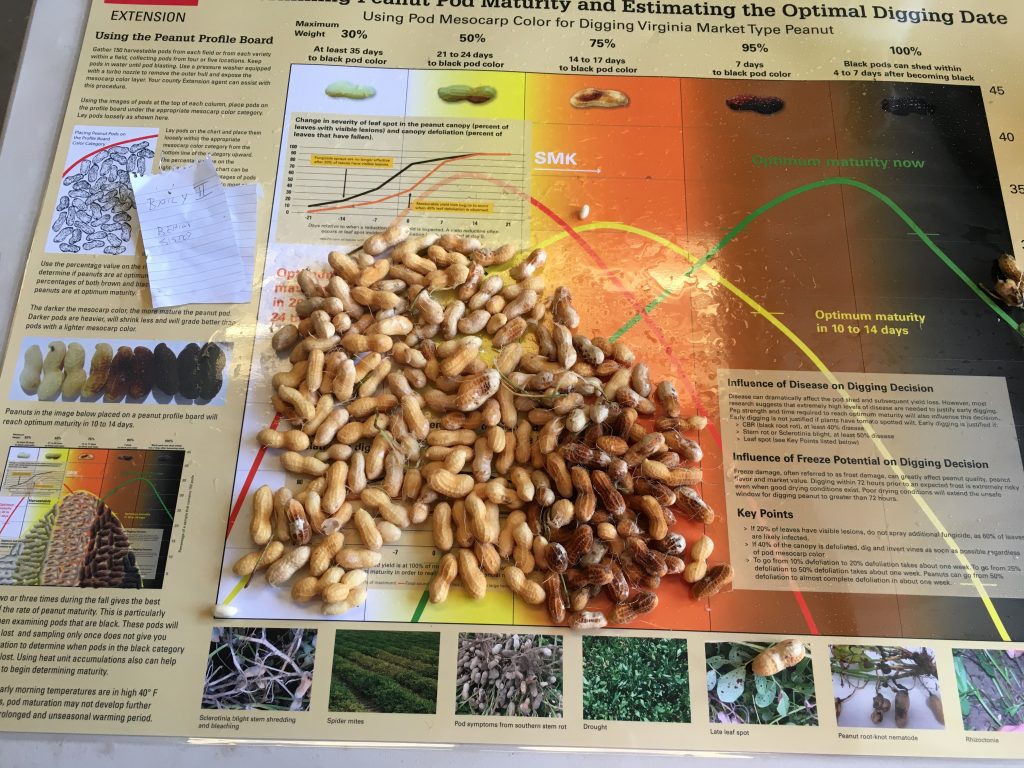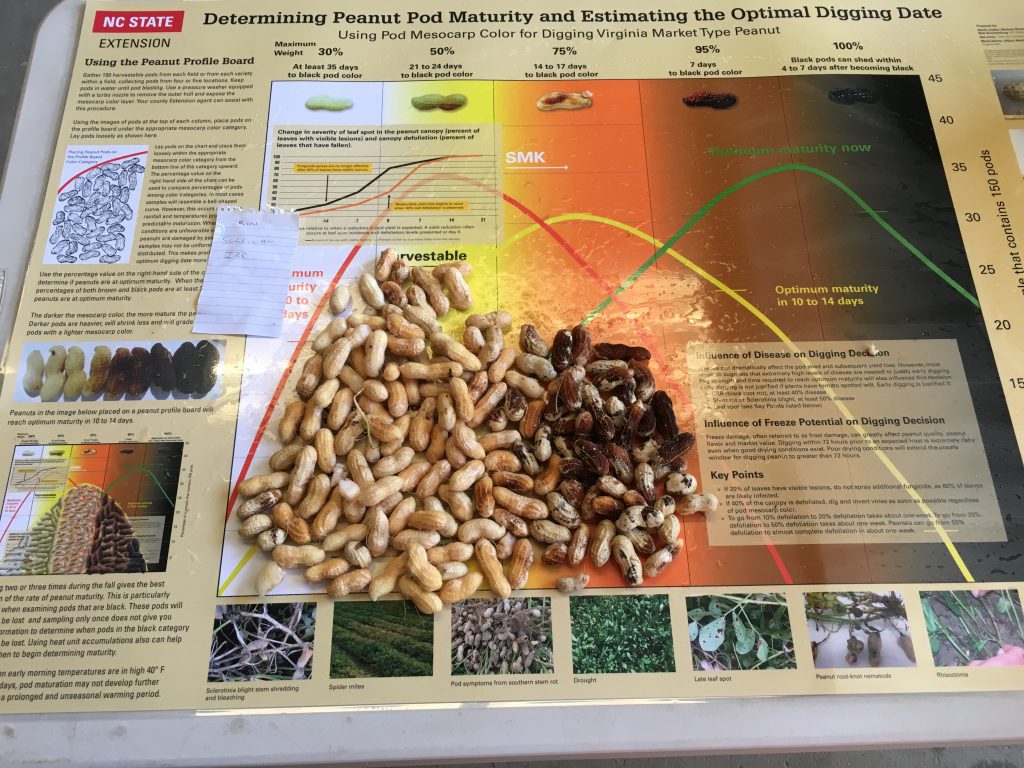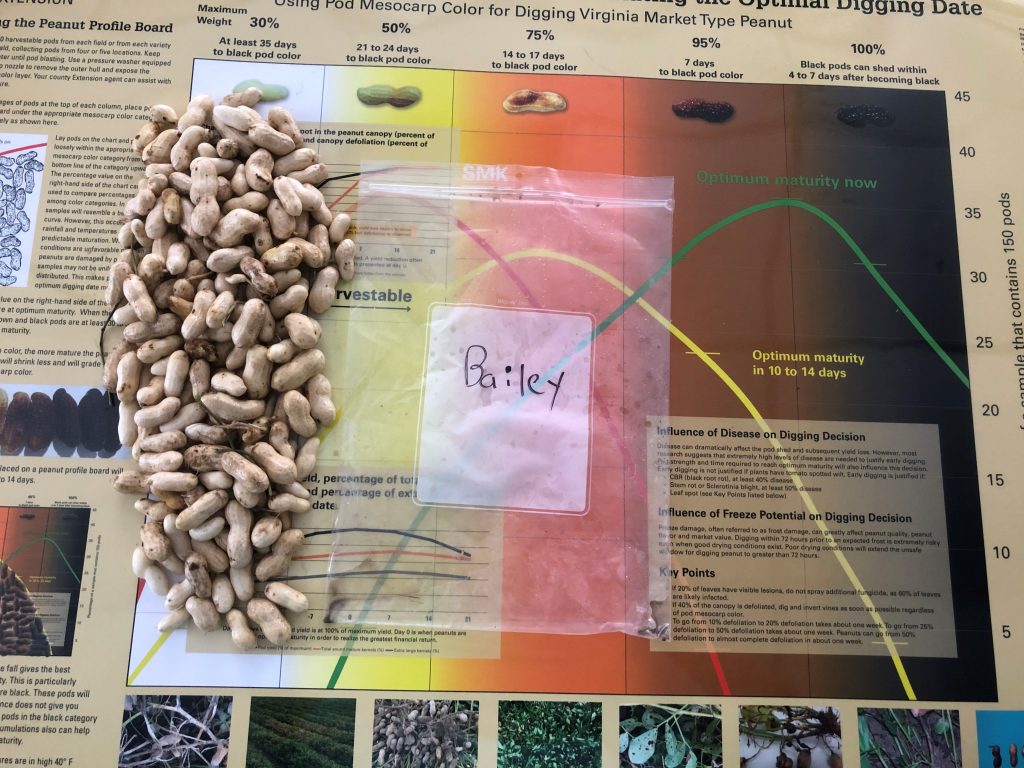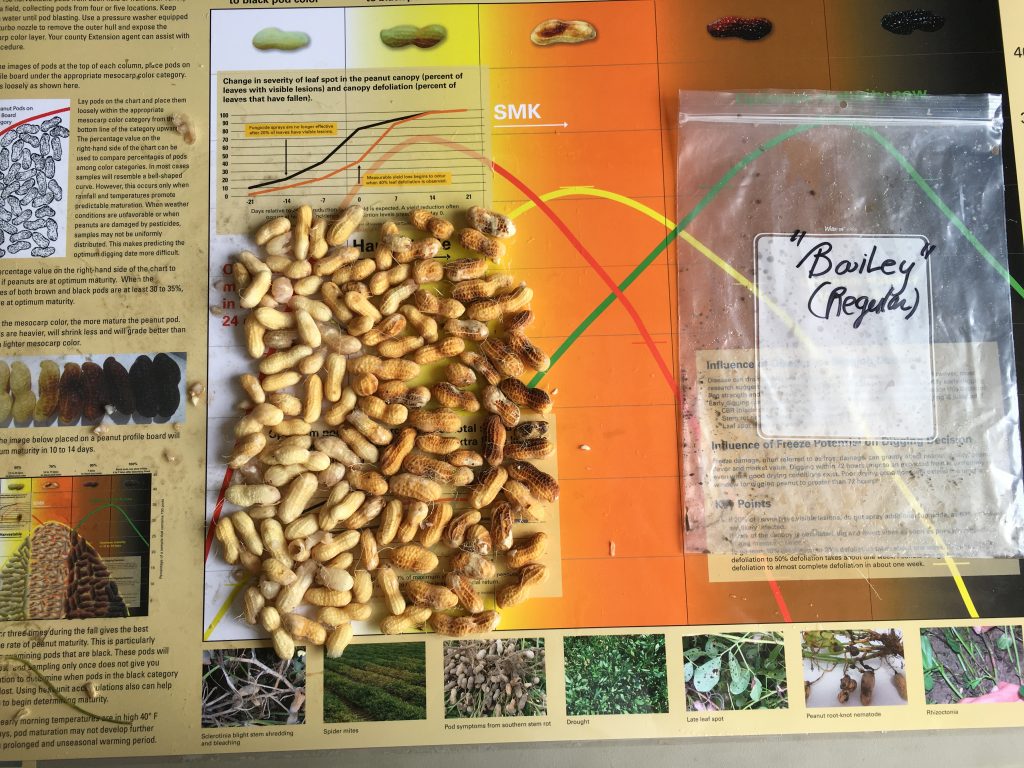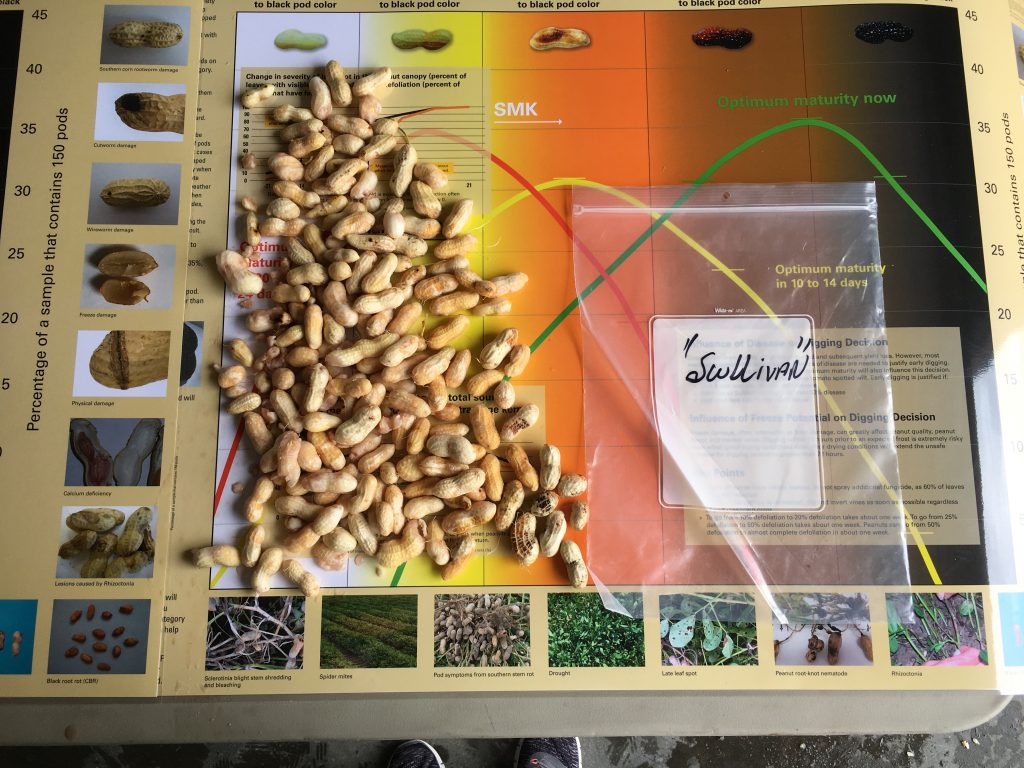Next week on Sep 8, 2021, Tidewater Agricultural Research and Extension Center (TAREC) will host an “express” peanut field tour. With registration starting at 7:30, attendees will be updated on peanut research on disease, insect and weed management, as well as varieties recently released and in the pipeline for release. Pod maturity of the currently most significant cultivars will be observed. Last but not least, the participants will have the opportunity to be welcomed and interact with the TAREC’ s new Director, Dr. Matthew Chappell. The agenda and map to the tour is here.
Author Archives: Maria Balota
We are not there yet, but getting close!
Today, Aug 26 2021, we pod blasted a few peanut cultivars grown at the Tidewater AREC in large plots to observe pod maturity at this time. While the peanuts planted in the first week of May might be ready in 20-25 days from now, those planted in late May are approximately 30 days from the optimum maturity. Keep in mind that weather is also a decisive factor; therefore, sampling for maturity again in 10-14 days from now will allow to pinpoint more accurately the day when peanuts are ready for digging.

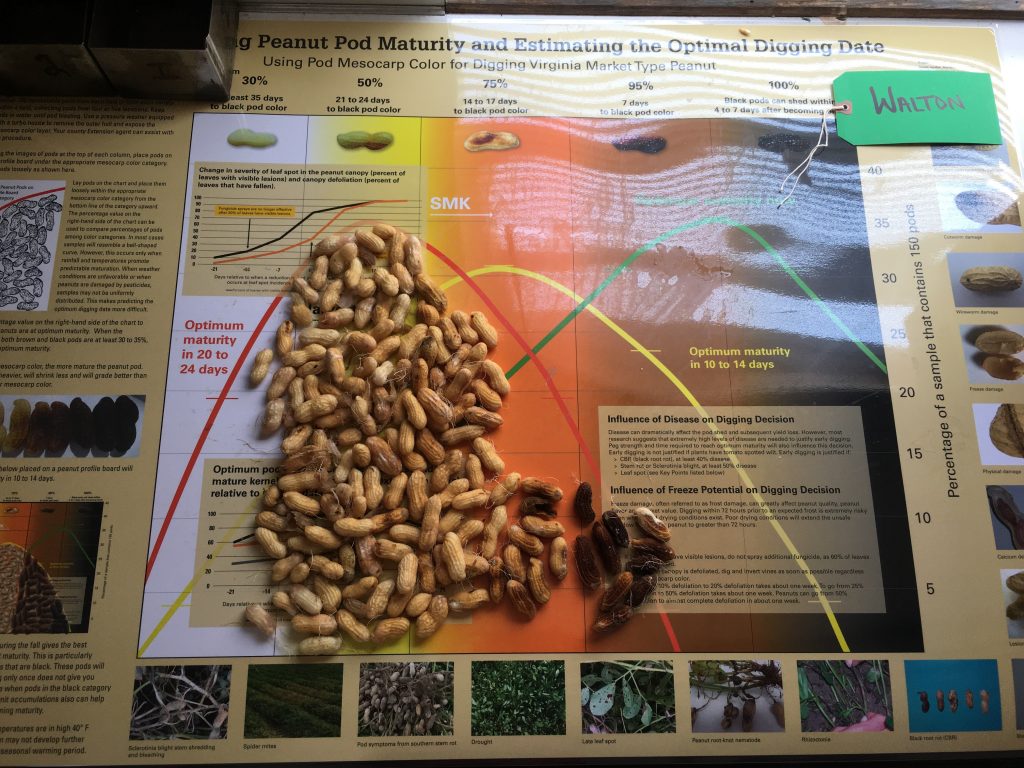


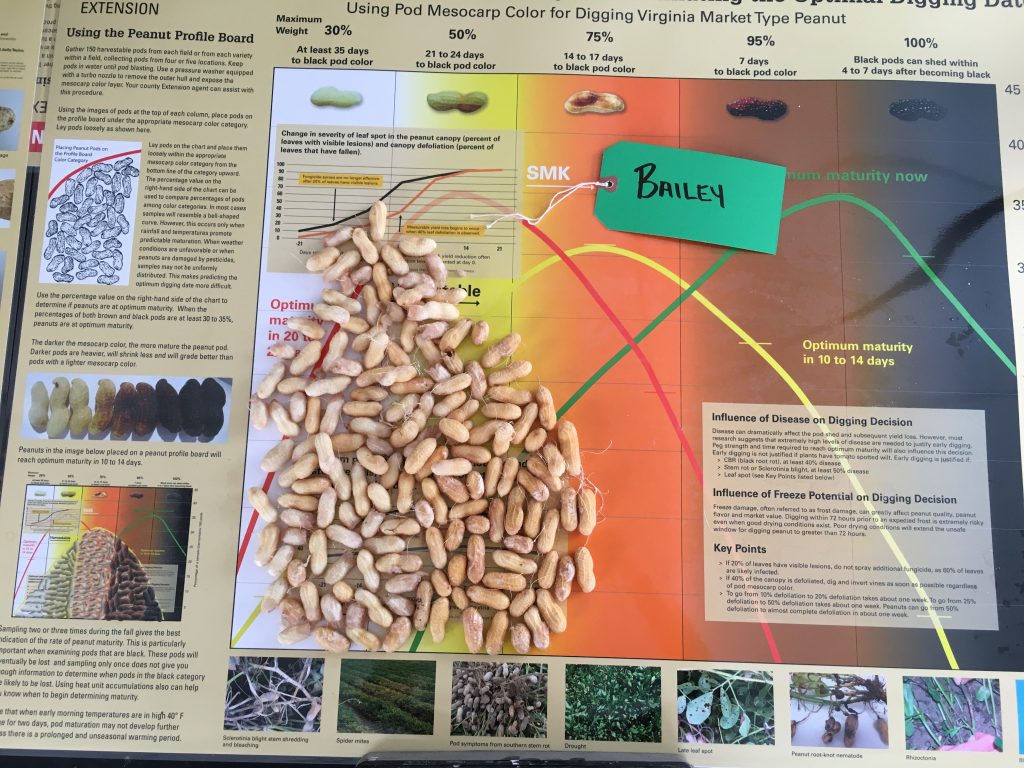
Peanut Maturity in SE Virginia on Sep 28, 2020
I know I missed a week of updates, but it was not much change in peanut maturity since recently. On Sep 28, however, some fields started looking close to digging. While some fields in theory still need three weeks to mature, others can be dug soon (see picture below showing samples of ‘Sullivan’ peanut planted at about the same time but in different fields with different conditions through the summer).
Maturity of peanut in Isle of Weight County, VA, on Sep 28, 2020. Samples are from different fields planted with Sullivan in mid-May.
Similarly, cultivar ‘Bailey’ showed variable maturities depending on the soil type, growth conditions, and irrigation. But in majority of approximately 35 samples looked at on Sep 28, Bailey seemed ready to dig starting within the first week of October.
With the exception of Bailey, peanut cultivars currently grown in Virginia have the high oleic oil chemistry. Thus, it is important to realize that cooler temperatures at this time of completing maturity may affect the high oleic oil chemistry. Research showed that temperatures in the range of 85 to 90 F during pod filling to harvest increased the oleic fatty acid content, which makes peanut a high oleic peanut; while lower temperatures promoted the linoleic fatty acid. I hope not, but if research proves right for our late maturing peanut this fall, when temperatures dropped in high 60’s or at the most 70’s for the past 3-4 weeks, this determination should be made as soon as first peanuts are picked and measures taken. This is particularly important for Virginian growers that primarily grow peanut for certified seed production.
Sample of ‘Bailey’ peanut in Isle of Weight County, VA, on Sep 28, 2020.
Peanut Maturity in SE Virginia on Sep 15, 2020
Frank Bryant pod blasting the peanut pods (left) and growers commenting on the pod samples (right).
Monday, Sep 14 2020, Extension Agent Livvy Preisser organized a pod blasting clinic in Windsor, VA, at the Indika Farms Inc.
As every year my technician, Frank Bryant, assisted the Agent with this activity. Keeping the distance, several growers brought over 25 peanut samples from almost 2000 acres from the neighboring fields.
In average, peanut still needs 3 weeks or longer to complete physiological maturity, regardless if the fields were or not irrigated. From all, only one sample of non-irrigated Sullivan was 2 weeks closer to digging. This agrees with what we have observed in the research plots this week.
Maturity of peanut in Isle of Wight County, VA, on Sep 14, 2020. Samples are from different fields, Bailey (upper left and center), Bailey II (upper right), and Sullivan (below).
Additional pod blasting clinics will take place on Sep 16 at Carolina Easter, Courtland, VA; Sep 18 at Meherrin Ag. & Chemical, Capron, VA; Sep 22 at TAREC, Suffolk, VA; Sep 23 at Carolina Eastern, Courtland, VA; Sep 25 at Meherrin Ag. & Chemical, Newsoms, VA; and Sep 28, at Indika Farms Inc, Windsor, VA. They are organized by Extension Agents Livvy Preisser, Elisabeth Pittman, and Josh Holland.
Because temperatures of the past 3 weeks seem to decrease in the next 3 weeks and into the Fall by 15 to 20 F daily, from high 80s and on some days mid-90s to only mid-70s, the rate of pod development from immature (white mesocarp color) to mature (brown and black color) will decrease as well. Therefore, patience is needed with peanut crop this Fall for harvesting high yields and SMK in Virginia.
Peanut Maturity in SE Virginia on Sep 8, 2020
In the past two weeks, peanut progressed nicely towards harvest maturity. The pictures below show maturity of Bailey on Aug 25 and Sep 8, 2020; and maturity of Sullivan and Emery on Sep 8, in fields at the Tidewater AREC, Suffolk, VA. Recent good soil moisture and high temperatures, not many exceeding 95 F, seem to close the gap between last and this year’s harvest time. It is, still, very improbable to have an early digging, like we have had in the past two years when peanut was complete dug by end of Sep in Virginia. Maybe by the end of Sep, 2020, we will start digging some early planted fields. I will provide weekly updates.
Bailey planted May 14, 2020 and pod blasted on Aug 25 (left) and Sep 8 (right), 2020.
Emery (left) and Sullivan (right) planted on May 14 and pod blasted on Sep 8, 2020.
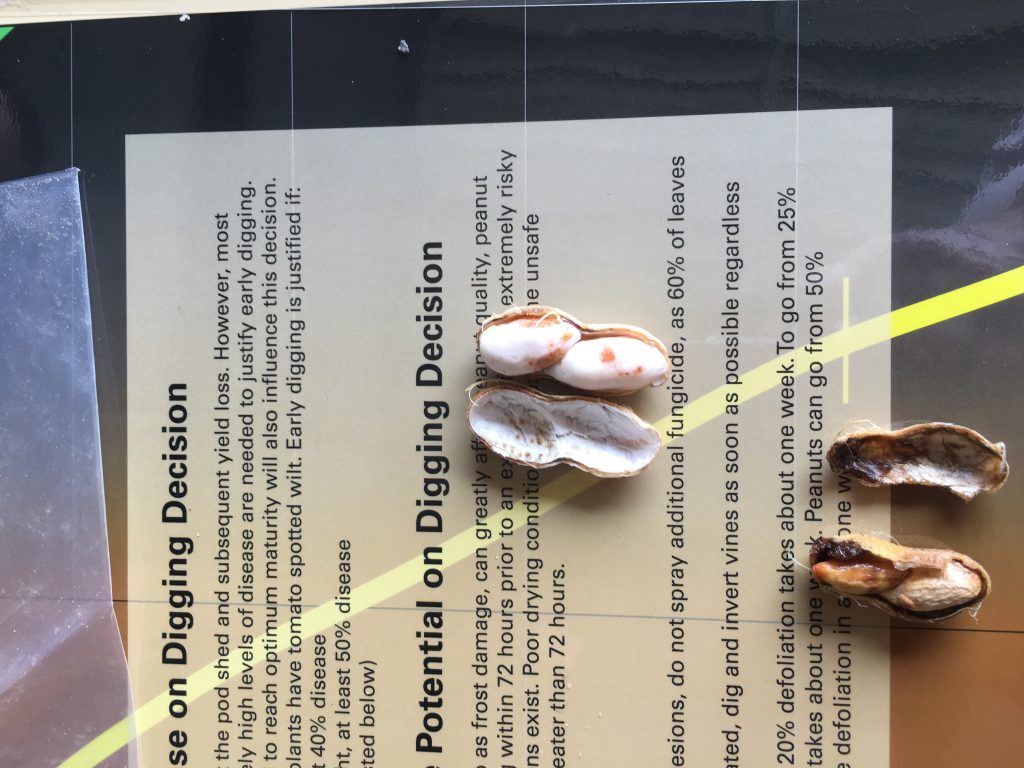
Peanut Maturity in SE Virginia on Aug 25, 2020
This year, peanut is nowhere near where it was last year, from the pod maturity point of view. The pictures below show 100% white (immature) pods from Bailey planted on May 14, 2020, and collected on Aug 25. Last year, on Aug 27, pods of Bailey planted on May 3, 2019, ranged from 10% white to 25% brown and black (fully mature), with the majority in yellow and orange mesocarp color denoting substantial progress towards physiological maturity. Indeed, in 2019, peanut was planted earlier than this year, but this only explains part of the reason why this year peanuts are maturing later than in 2019. The other part comes from the dry and hot July, when pollination, and growth of pegs and pods were slowed down. Tropical storm and other rain events at the end of July benefitted pod development, but maturity is still delayed from the last season. I am showing pictures only from Bailey, as the main cultivar grown on 50% of the peanut acreage this year; but we looked at Sullivan, Emery and Wynne as well and they look similar with Bailey. This year, we also noticed on all these cultivars a fair amount of Southern corn rootworm and other pod damage, regardless the soil where pod samples were collected at the Tidewater AREC. I will continue updates on peanut maturity every other week.
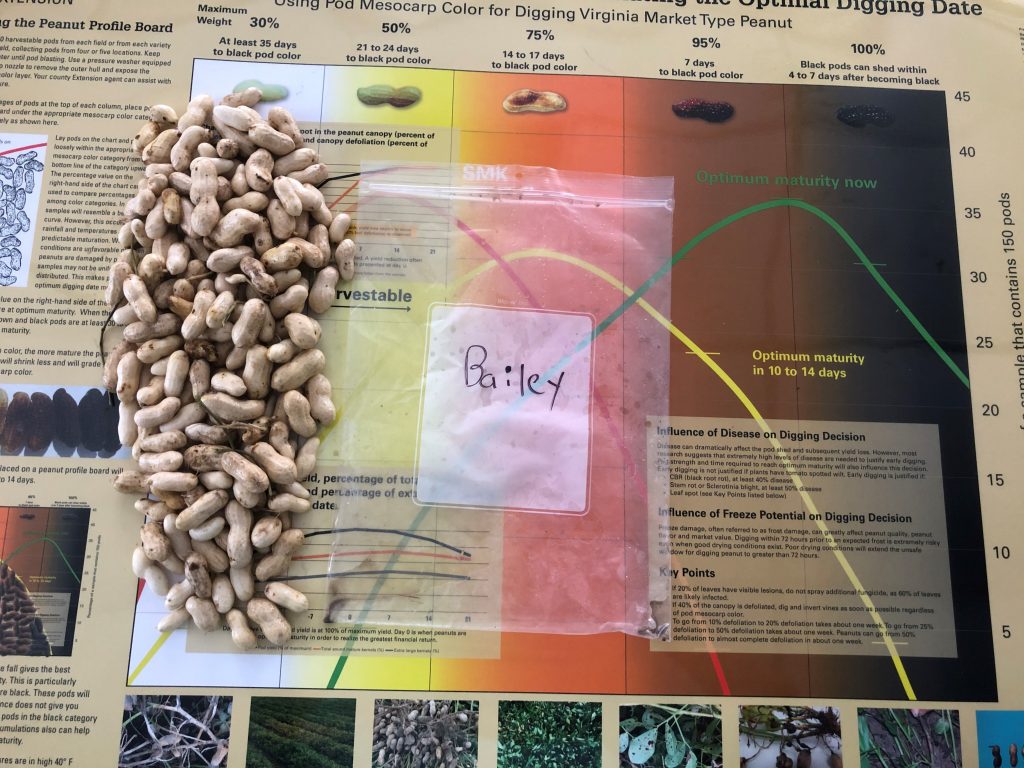
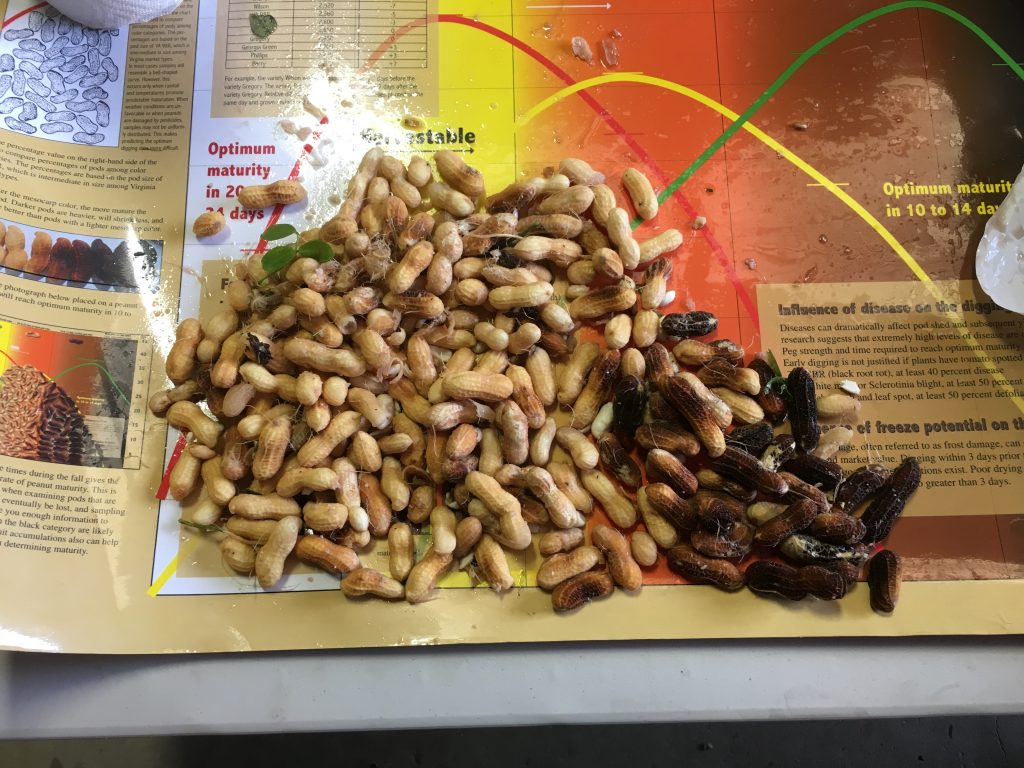


Update on peanut maturity, Aug 28
On Aug 26, a pod blasting clinic has been organized at the Indika Farms in Windsor, VA. A total of 24 samples (fields) representing 1056 acres were evaluated. Samples were from Isle of Wight, Suffolk, and a few from Southampton counties. Optimum digging for these samples was estimated to take place in 15 to 30 days from Aug 26, with the majority of the samples showing to be ready in 20 days. Dates for future pod blasting clinics are Sep 9 at Indika Farms (contact Livvy Preisser livvy16@vt.edu for details), Sep 4, 10 and 18 in Southampton (contact Joshua Holland cvfd262@vt.edu for details), and Sep 19 in Greensville (contact Sara Rutherford sriggan@vt.edu for details).
A few pictures from Aug 26 pod blasting clinic are shown below.
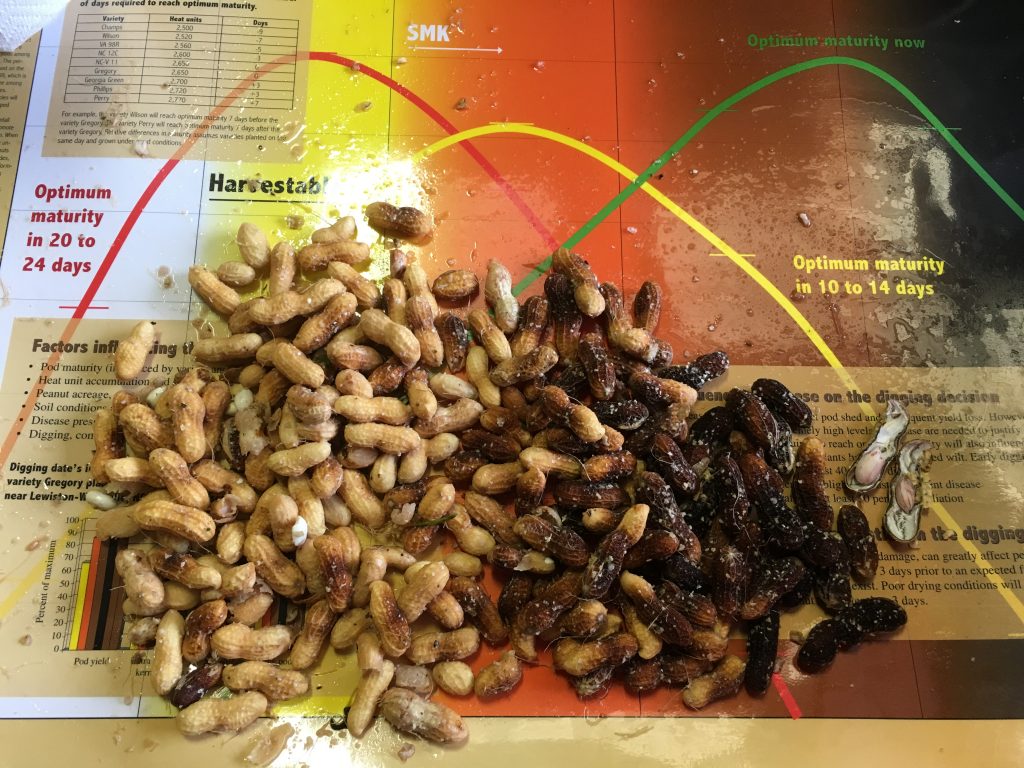
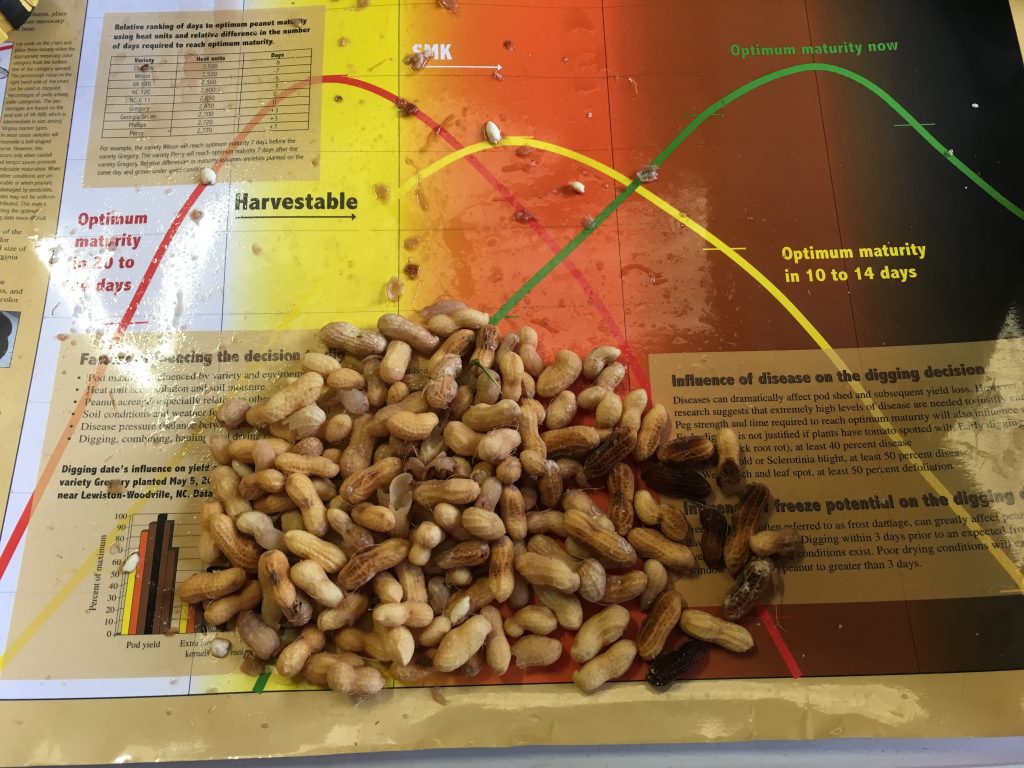
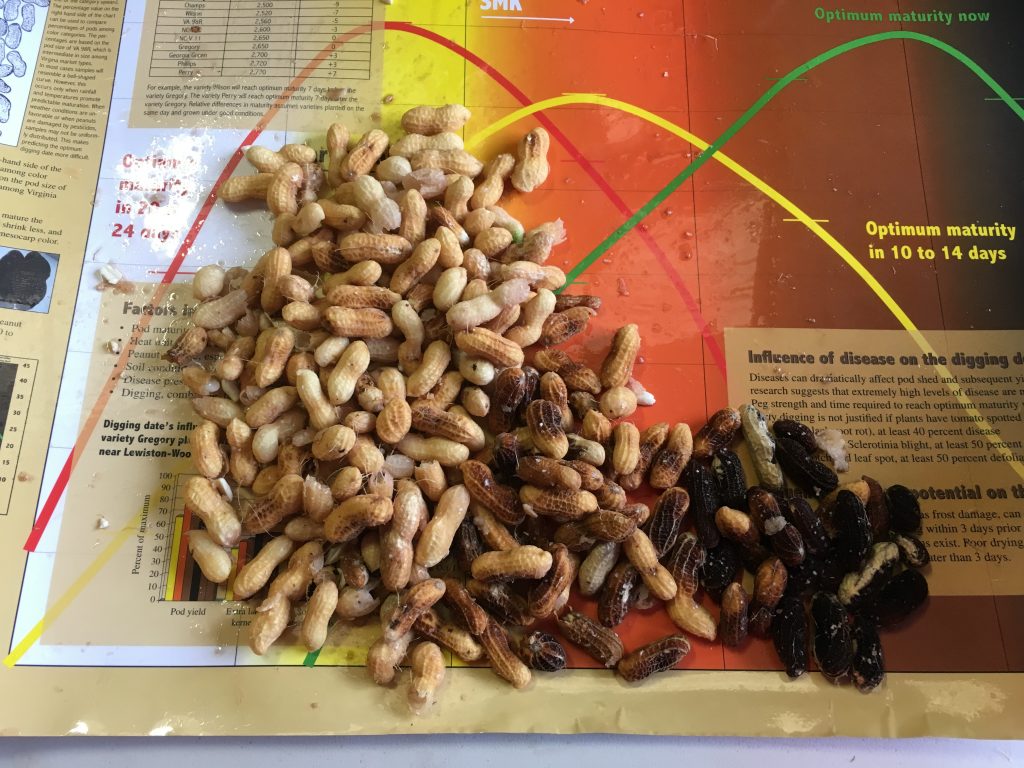
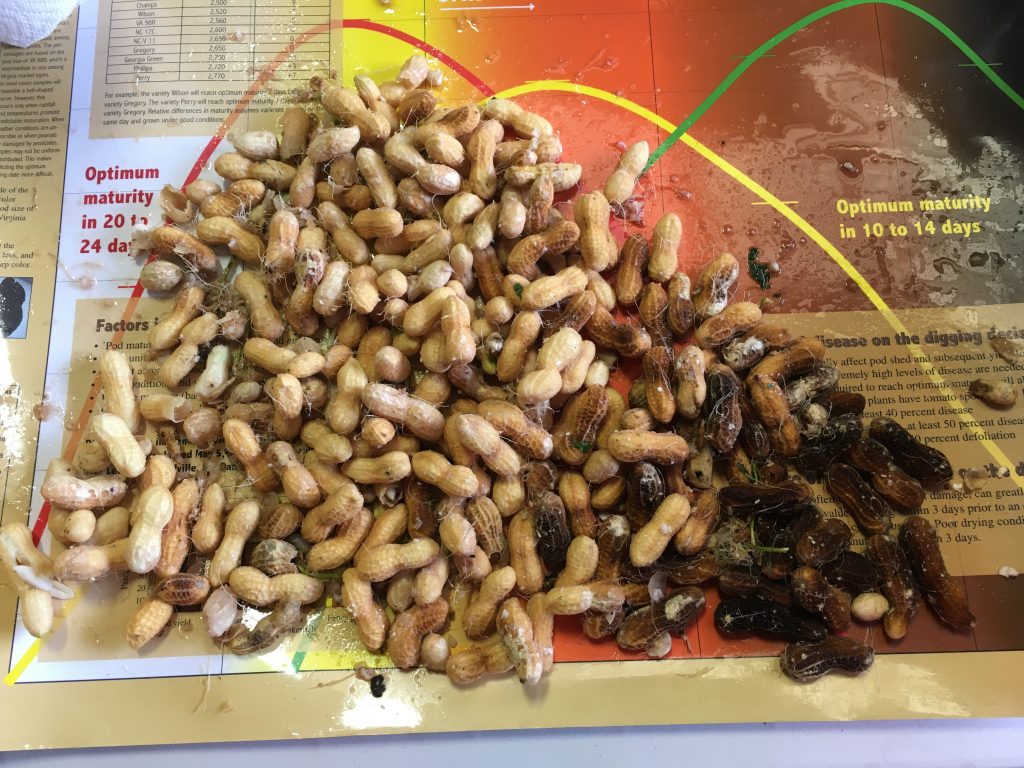
Peanut maturity in Suffolk, VA (planted on May 15 and dug on Aug 13)
According to the Peanut – Cotton Infonet (https://webipm.ento.vt.edu/cgi-bin/infonet1.cgi) online report system, peanut planted on May 1st in Suffolk, Capron, Greensville, and Waverley, VA, accumulated to the date around 2100 °F in all these locations. It is good to remember that the Virginia-type cultivars grown in Virginia requires around 2600 °F to reach harvest maturity. With sustained daily temperatures at around 90 °F, physiological maturity could be reached in a week or two, then? It is incredible early for a “normal” year but nothing impossible, as the last year taught us.
Choosing when to dig is a big decision and no one should rush to it without checking the maturity first. If dug too early, yields will be significantly reduced from immature seeds (small sound mature kernel and extra-large kernel content on a farmer stock grading rating); this will substantially reduce the price per ton. Immature peanuts of the “high oleic” cultivars like Sullivan, Wynne, Emery, Bailey II, and Walton may not reach the threshold 75% oleic fatty acid content required for the high oleic seed to pass the high oleic standard; this may downgrade the certified seed to commercial status and, again, reduce the farmers pay per ton. If waiting too long, over-mature kernels will drop off the vines before being picked by the combine, and yield and pay will be substantially reduced in this way. For example, if only one pod per square foot is shed from over-maturation, the loss per acre could be 100 pounds per acre for Bailey and Sullivan, and even more for Wynne and Emery. Usually, pod shedding can easily cause 25% yield reduction.
When to dig is, therefore, better to be a knowledge-based decision. This is now possible by the availability of peanut “maturity charts” and pod-blasting “clinics” organized by the Extension Agents and Specialists of the Virginia Coop. Ext. program; clinics will start by end of Aug and continue through end Sep in several counties in SE Virginia. For example, Indika Farms will host one on Aug 26 starting at 8:00 AM in Windsor, VA.
To provide some guidance for when to start maturity evaluations, pod-blasting of three major cultivars was performed on Aug 13 and images are presented below. Pod samples are from one single field at the Tidewater AREC planted on May 15. As pictures show, the majority of the pods are yellow with less than 20% immature (white or green) and very few orange. Kernels are well developed inside the yellow pods and the orange pods have thin and darkened hulls inside, which is a clear indication that maturity has begun. I will continue to update on the peanut maturity progress in Virginia in the coming weeks.
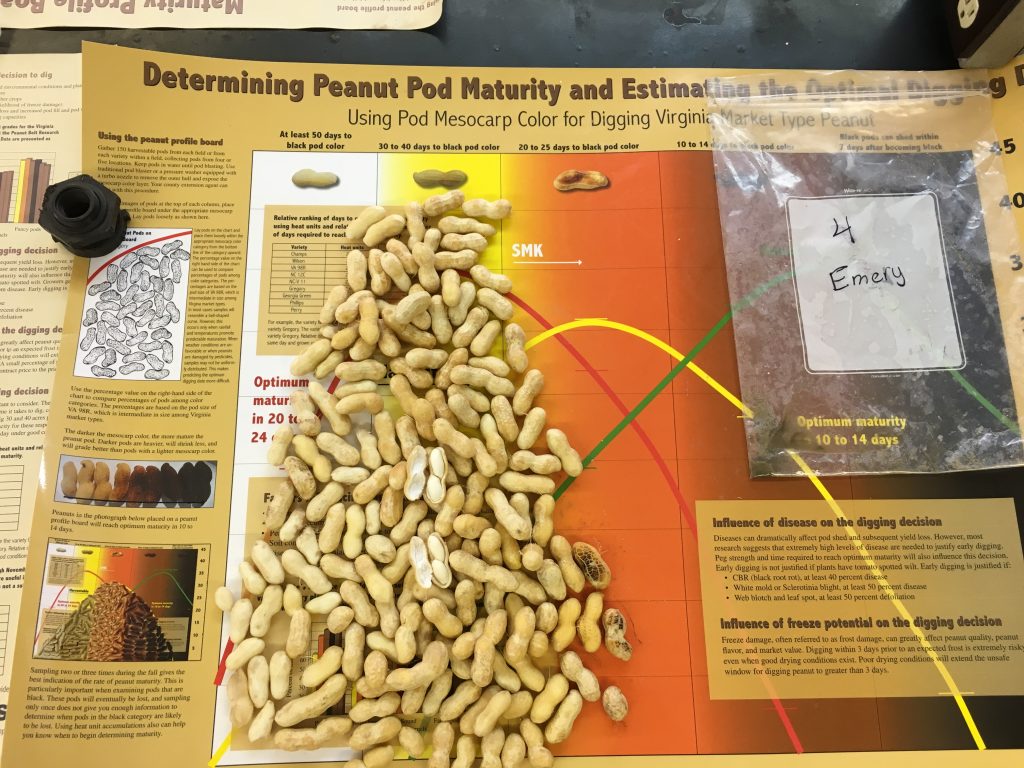
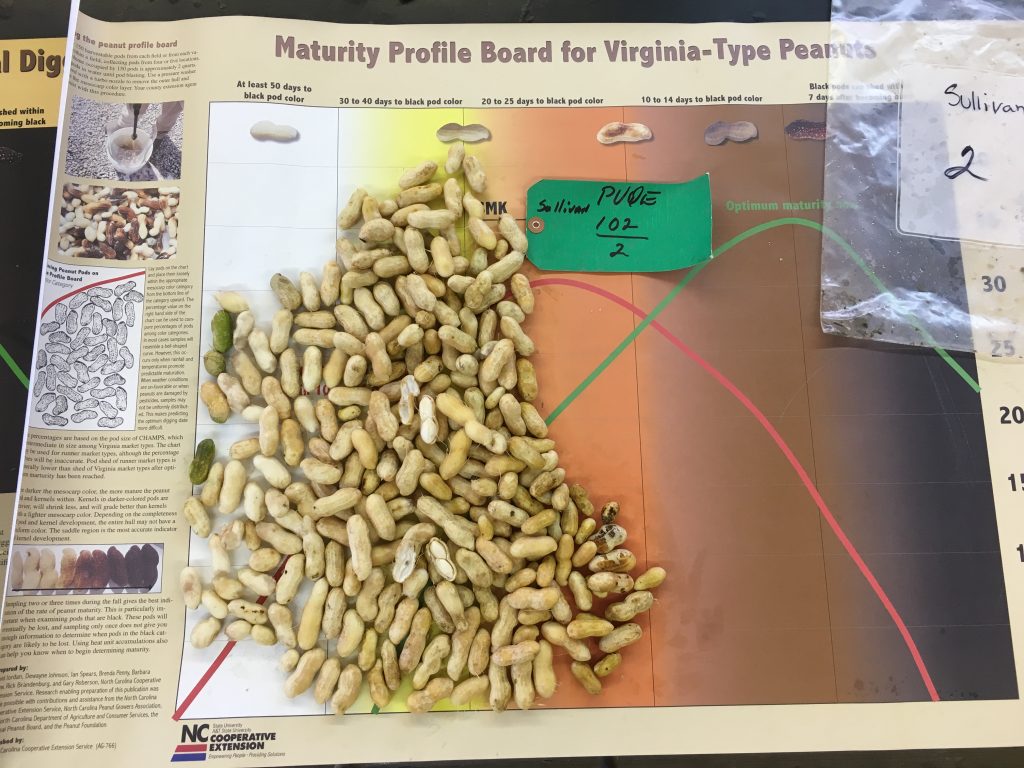
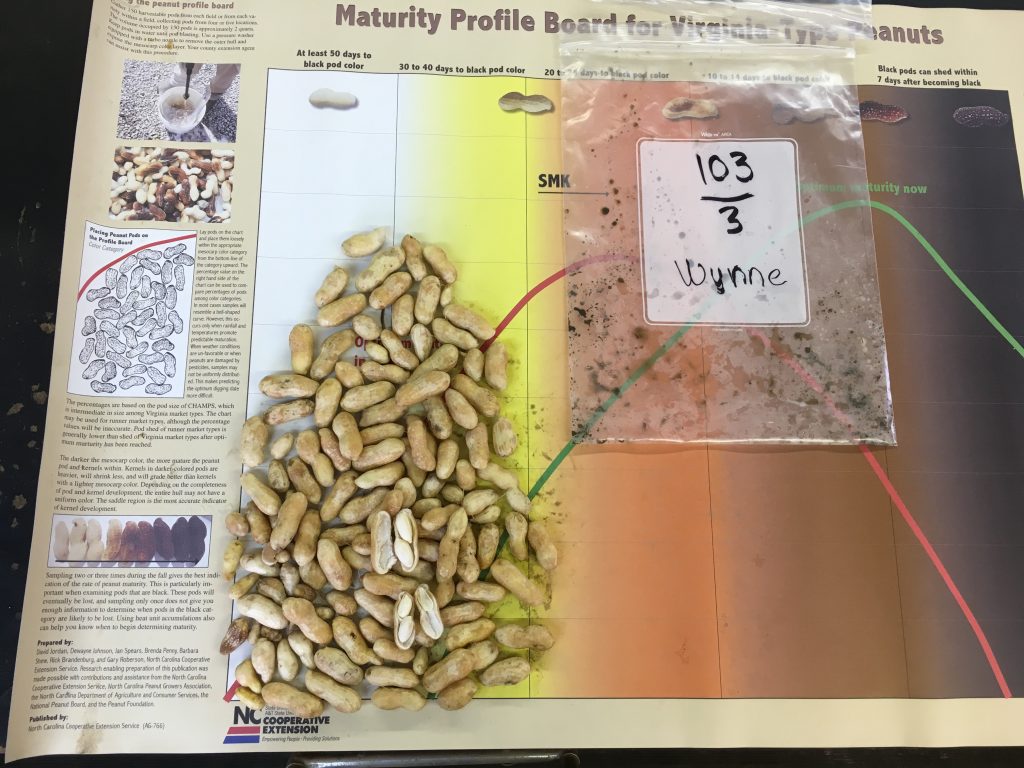
‘Walton’ a New High-Oleic Virginia-Type Peanut
Early this year, ‘Walton’ peanut was jointly released by Virginia Tech and the University of Florida. Walton is a Virginia-type peanut (Arachis hypogaea L. subsp. hypogaea var. hypogaea) cultivar with similar good agronomic performance when compared with Bailey, Emery, and Bailey II under “normal” production (Table 1), but with superior performance than these cultivars under extreme water deficit conditions. Seeds are elongated in shape and seed testa color is light pink to pink. It has dark green foliage; an intermediate growth habit and the main stem is not distinguishable from the lateral branches. Walton is a high-oleic cultivar with maturity similar to Virginia-type cultivars developed for the VC region. Breeder seed is being increased at the University of Florida in 2019, and more will be produced next year at the Tidewater AREC and in Florida. For commercial production, seed will become available at the earliest in 2021.
Table 1. Results of the Peanut Variety and Quality and Evaluation multi-state (VA, NC, SC), multi-location (5), multi-year (4) (2015-2018)
| Variety | Yield (lb/A) | Crop value ($/A) |
| Walton | 5334 ab | 940.0 a |
| Bailey | 5243 abc | 920.5 ab |
| Bailey II | 5515 a | 978.1 a |
| Emery | 5048 bc | 892.5 abc |
| Sullivan | 4876 c | 831.6 bc |
| Wynne | 4859 c | 826.4 c |
| Mean | 5146 | 898.2 |
| P>F | 0.0128 | 0.0072 |
More information it can be found here Walton’ a High Oleic Virginia-type Peanut. Walton will be presented at the VA Peanut Tour on July 30th, at Tidewater AREC.
VA Peanut Tour – July 30, 2019
Tidewater AREC will host the 2019 Virginia Peanut Tour on July 30th. The flyer of the event is here July 30_Flyer.


